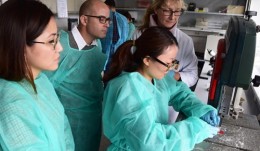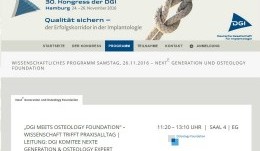-
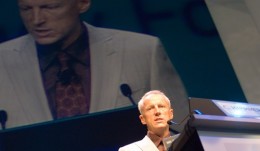

Christoph Hämmerle: with team effort and trust to success and reputation
Professor Christoph Hmmerle has served as president of the Osteology Foundation for 12 years. His term of office came to a close at the end of May 2015. In an interview, he looked back over the past 12 years and how the Osteology Foundation has developed since it was founded by Dr Peter Geistlich, who he reveres with gratitude and respect. The Osteology Foundation was founded 12 years ago, and you have been its President since then. It seems that the Foundation has now grown up as it were. What are your recollections, when you look back on the development of the Foundation? Christoph Hmmerle: The Osteology Foundation has grown to be a highly respectable organization over recent years. I think the key elements for this success have been the excellent teamwork among the members of the Foundation Board, the dedication of those working in the office and, very importantly, the support and the academic freedom granted by the Founder Dr Peter Geistlich. When you look back, what were the highlights during those 12 years? Christoph Hmmerle: The development of the Osteology Foundation has been a continual step-by-step process. There were many highlights during this development. Some key events surely were the National and International Osteology Symposia, which have grown steadily in size and reputation. Another important aspect has been the grant program providing support of research projects, which has led to many publications advancing soft and hard tissue regeneration in science and practice. Yet another true highlight was the development of the Osteology Research Academy (ORA). This Academy offers education in research methodology to anyone interested and allows the participants of the courses to gather knowledge, acquire skills, as well as build and develop valuable research networks. The Foundation was founded by Dr Peter Geistlich in 2003. How was your relationship with him? Christoph Hmmerle: He truly was an elder statesman, a charismatic person who was very much respected by those around him. I enjoyed a trustful and respectable relationship with him. When I think of him, it is with gratitude and respect for what he did, what he achieved and who he was. Can you share one or two personal moments with Dr. Peter Geistlich that you remember well? Christoph Hmmerle: I felt very touched, when he offered me first name terms during a dinner. I know that he only offered this to a few people. I interpreted it as a sign of his trust in me and in our relationship. I also remember very well the charismatic way in which he made his statements, when we did recordings for an Osteology film. And another situation that sticks in my mind was during the Osteology Symposium in Monaco in 2007, when I had the honor of presenting him with a gift. He was a rather reserved person, who usually didnt like to be at the center of attention. But on this occasion he came onto the stage to accept the gift and the gratitude of the audience. Did the Foundation experience any crisis or major problems during your 12 years of presidentship? Christoph Hmmerle: No, we never experienced a crisis. There has always been a high level of dedication from the Osteology Office, sustained support from the founder and enthusiasm for the Foundation and its causes from within the Osteology Board. Of course, there were situations and decisions that called for intensive discussions, but ultimately we always found beneficial solutions paving the way for further progress of the Foundation. It seems that the Osteology Foundation managed to put a large proportion of ideas into practice. It now offers a broad range of activities and tools for Scientists and Practitioners. At the outset, did you expect that the Osteology Foundation would grow to such an extent and become so successful? Christoph Hmmerle: Definitely not. We did not foresee this significant and wonderful development. All this became reality, because we recognized the needs in this field, reacted to changes, identified important gaps and reacted positively to all these challenges. We responded to the needs in the field by offering education and training for researchers and clinicians, providing meaningful information in the form of research guidelines, offering grants for research projects, organizing funding for academic scholarships, reflecting the state of the science by conducting consensus conferences, etc. Looking back over the past 12 years of the Foundation, we have clearly offered value to the community, which has been well received and has significantly contributed to the positive development in the field of hard and soft tissue regeneration. Is there something of which you are particularly proud, or something special that you feel you have personally achieved during your presidentship? Christoph Hmmerle: I believe it is most important that everybody has had the opportunity to put their influence and personal strength to good effect. Within the Board, the Office and the relationship with the Founder, there has always been a spirit of trust and respect allowing everyone to work to the best of his or her capabilities. I consider this one of the most important aspects in the success of the Osteology Foundation. You are not saying a final farewell to the Foundation when your period of office ends in June. You will remain a member of the Foundation Board for two more years. Are there any specific projects that you plan to realize during this time? Christoph Hmmerle: When ones term is over, it is time to step down. But of course, I will provide support and advice where needed. With the new members of the Board and the Executive Board I am fully convinced that there will be further positive development of the Osteology Foundation. At this point, I would also like to express my special thanks to the Board of Directors of Geistlich, in particular to Dr Andreas Geistlich, for having affirmed their continued support for the future of the Osteology Foundation. When you are no longer president of the Osteology Foundation, what are you going to do with the plentiful free time you have? Christoph Hmmerle: I will have more time to further develop online education. I am fully convinced that online education is becoming a key platform for the exchange of knowledge and for communication in our modern interconnected world. We started a project called Dental Campus back in 2007, which is unique and has a great potential for further development. So, maybe there will be not so much free time waiting for me. But of course I will also enjoy having more time to spend with family and friends, doing sports or being in the mountains. Mariano Sanz will be the next president of the Osteology Foundation in June 2015. Is there something that you would like say to send him on his way? Christoph Hmmerle: I have known Mariano for a long time and we have worked together for several years and on various projects. He is highly experienced and well established as a researcher, a clinician, an academic and a leader. With him as President, the Osteology Foundation will be in the best possible hands! Thank you very much, Professor Hmmerle! Interview: Dr Heike Fania -
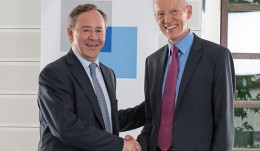

Hand-over of presidency in Zurich
On the occasion of the Osteology Board Meeting on June 22, 2015 in Zurich, the presidency of the Osteology Foundation was officially handed over from Christoph Hmmerle to Mariano Sanz. Professor Christoph Hmmerle served as president of the Osteology Foundation for 12 years, ever since it was established. Looking back at his term of office, he said in an interview prior to the meeting in Zurich: The Osteology Foundation has grown to be a highly respectable organization over recent years. I think the key elements for this success have been the excellent teamwork among the members of the Foundation Board, the dedication of those working in the office and, very importantly, the support and the academic freedom granted by the Founder. Read the full interview with Christoph Hmmerle Even though his term of office as president of the Osteology Foundation has ended, Christoph Hmmerle will remain a member of the Board for two more years, contributing to the development of the Foundation and its activities with his great experience and knowledge. Professor Mariano Sanz, who in Zurich officially took over as new president of the Osteology Foundation, has been a member of the Board for 12 years, he also served as Chairmen of the Education Committee and Member of the Executive Board for several years. For him, the Foundation and its activities are therefore already familiar - with Mariano Sanz, the Osteology Foundation is in the best hands, said Christoph Hmmerle. Mariano Sanz thanked him, and said that in the past 12 years Christoph Hmmerle has done a superb job. Not only as a result of his vision and work, but also through his personal and social skills has the Foundation become a friendly family of leaders all striving for the same objective, which is to fulfil the mission of the Osteology Foundation. Mariano Sanz does not intend to change the strategy of the Osteology Foundation. We will continue the successful work, and wherever possible extend it to other parts of the world, he said in an interview, and added: we shall consolidate our accomplishments, but at the same time open up to new technologies and improve communications media with the goal of widening our reach in order to better fulfil our mission. Read the full interview with Mariano Sanz -
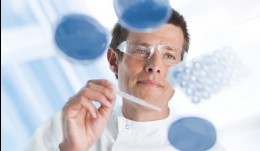

New Large Clinical Grants Programme
The Osteology Foundation calls for applications for the new Large Clinical Grants. Theprogram aims to support hypothesis driven clinical research by well-established research groups with demonstrated clinical research expertise. There are two stages in the application process: Stage 1 Applicants can submit an abstract of their proposed project by15 November. The Osteology Science Committee selects projects which then progress to the next stage. Stage 2 Applicants are invited to submit their full application. The submissions are then evaluated for potential funding by the Osteology Science Committee. Study types Research types falling within the scope of the Osteology Foundation are for example: RCT (also small multi centres) and quasi RCT Case controlled studies Prospective cohort studies Surgical techniques (also in combination with biologics, drugs and devices) e.g.: Biologics Dugs (also e.g. phase I / phase II - pilot studies, proof of principle) Devices (also e.g. phase I / phase II - pilot studies, proof of principle) Combination products Who can apply? Well-established research groups that demonstrated clinical research expertise. Amount of funding Grants are limited to 350000 Swiss Francs with a maximum project duration of three years. Awarding criteria Hypothesis answering a clinical research question relevant to the field of oral and maxillofacial regeneration Methodology Facilities and expertise to conduct a GCP study Sound and transparent budget Application guidelines Apply now! -
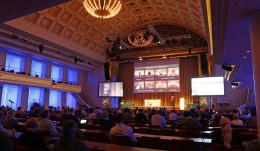

Osteology Baden-Baden: Practical questions in daily routine
Amid friendly autumn weather, the Osteology Foundation welcomed over 300 delegates in Baden-Baden to the 5th National Osteology Symposium from 18-19 September 2015. Scientists and practitioners from Germany, Switzerland and Italy met under the motto Science-based treatment concepts for dental practice. The focus was on practical questions from the daily routine of regenerative dentistry. Scientific evidence as a basis was always taken into account. A total of 34 industry exhibitors sponsored the workshops and the scientific symposium, thus providing participants with high level training as well as information about their products and services. INTENSIVE TRAINING IN 16 WORKSHOPS Friday was the traditional day for practical exercises. The workshops occupied the entire Baden-Baden congress house. Never before had that many workshops been on offer. The wide variety of 16 practical and theoretical workshops attracted close to 200 participants to topics such as extraction socket management, sinus, anterior tooth aesthetics, GBR, interposition, bone splitting, peri-implantitis, soft tissue surgery or the management of failures. The focus was on extensive hands-on training on animal specimens, which could then be applied in practice by the participants. Excellent organisation in advance and a structured approach was reflected by the relaxed atmosphere when welcoming the participants. This was acknowledged by feedback from the participants, stating they had rarely encountered such a stress-free and relaxed further education event at such a high level. PRACTITIONERS FORUM 20 success factors relating to tissue regeneration were presented in the forum for advanced practitioners led by Professor Friedrich Neukam. In front of an audience of some 50 participants, Dr Matthias Mller, legal counsel to the DGMKG, kicked off the session and spoke on current legal issues relating to surgical intervention. Professor Ralf Rler presented measures on the successful treatment of infections and Dr Oliver Brendel discussed the various implant concepts and timings from a prosthetic point of view before the break. In the second half of the session, Dr Gerd Krner provided insights on what needs to be considered when transforming severely periodontally damaged teeth into an aesthetic piece of artwork. Dr Christian Hammcher and Dr Jamal Stein presented their concept on managing peri-implantitis which they had developed and fine-tuned over many years. Dr Raoul Rendchen ended the session with an overview on the consequences of surgical malpositioning of implants. SCIENCE AT A HIGH LEVEL As the Osteology Symposium not only has the aim of bringing science into dental practices, but also wishes to support and enthuse young scientists as well as gaining their interest for the congress, a new highlight was provided by the scientific forum for young physicians which was held in parallel to the practice-oriented events on the Friday. With 23 poster submissions, the interest was overwhelming and by far exceeded initial expectations, so that the jury of the Osteology Foundation had to decide in advance which of the short oral presentations were to be admitted. Moderated by Professor Bilal Al-Nawas, Member of the Expert Council of the Osteology Foundation, Dr Birgit Schfer and Dr Peer Kmmerer held a presentation on the importance and numerous possible stumbling blocks in the field of biomaterials research as well as clinical research. The poster contributions and short presentations covered a variety of subjects, ranging from basic research to pre-clinical as well as clinical research. During the break, the roughly 40 participants had the opportunity of discussing their current priorities and results, including networking between the universities. Other interested delegates to the Osteology Symposium joined the young scientists, and all praised the high scientific level of the forum. TOP LEVEL SCIENTIFIC PROGRAMME Professor Friedrich Neukam opened the symposium on Saturday in the famous Benazet Hall of the Baden-Baden Kurhaus with an overview on the scientific commitment of the Osteology Foundation. A very special moment was the award ceremony of the Osteology Science Award for the best presentations in the scientific forum on the day before. The awards went to Dr Annika Kasten (Rostock) and Dr Martin Heller (Mainz), who each received a voucher for the Osteology Research Academy in 2016. The first third of the symposium under the aegis of Professor Ralf Rler was devoted to the clinical protocols and long-term success rates of treating alveoli. Dr Daniel Thoma gave an impressive presentation on the Zurich Concept, as to how and above all why, the various concepts ranging from immediate to delayed restorations can be differentiated. He also gave an outlook on how pending new developments can adapt the treatment of extraction alveoli even better to the needs of patients. Dr Christiane Kunert-Keil examined the orthodontic movement of teeth following augmentation measures, a topic which is still relatively new in terms of science. According to her experience, the augmented bone should not be too dense, however, following augmentation with Bio-Oss Collagen, loading can already be introduced after only a few weeks, which represents a major gain in time compared with the present standards. The fact that implant dentistry has meanwhile attracted a large field of users, was highlighted by Dr Mario Roccuzzo with his statement that while he used to receive referrals for implant placement, he is now more involved in saving implants. Using case studies, he demonstrated how ridge preservation techniques can be applied initially to facilitate implant positioning in order to achieve a stable outcome in the long term. The second session, headed by Professor Robert Sader, focussed on new insights in block augmentation. Professor Katja Nelson gave a presentation on what autologous blocks from different host regions can achieve and the problems encountered. According to her experience, the iliac crest graft is suited best, but harvesting is not always possible in daily dental practice. Here retromolar bone would be the first choice, but for reasons not yet known precisely, suitability is only limited for ridge preservation. The limitation of options was not only due the materials per se, but also due to the experience of surgeons. Professor Becker explained the main difference between allogenic and xenogenic bone replacement materials and presented the various studies his working group had conducted with blocks over the past years. He underlined that useful alternatives to autologous blocks could exist, if the choice of materials and technique were adapted to the biological limitations. Problems with dehiscences and infections usually occurred through over-contouring. However, as the time required for the complete reconstruction of autologous blocks takes approximately seven years, it remains necessary to conduct long-term studies with biomaterials as nobody so far knows how the alternative materials behave in the long term if an infection occurs. Professor Massimo Simion discussed the pros and cons of autologous and xenogenic blocks compared to bone chips and granules and demonstrated their areas of use as well as their limitations. Although block augmentation tends to show high stability in part, one can observe non-vital areas histologically after several years, whereas chips tend to vascularise rapidly as a rule and the graft contains considerably more vital bone. In the third part of the symposium, Professor Friedrich Neukam approached the topic of cross-border augmentation and avoiding errors before they occur. Professor Bilal Al-Nawas presented numerous cases at the edge of the abyss for iatrogenic-caused failures, for example due to incorrectly positioned or dimensioned implants, as well results following overload of the regenerative potential. According to the current guidelines and risk classifications, there are groups which can be well predicted in dental practice, groups which are questionable, and groups which should better not be included in the planning of augmentation therapies. In many cases, a lot can be gained if major augmentation is avoided and by proceeding step by step to keep the risks low. Professor Torsten Reichert concurred. His presentation focussed on patient-related factors which could lead to failure. One of the risks being, that various pre-existing disorders and treatments may have affected bone metabolism over the years or were, in part, not diagnosed at all. Often however, there was hardly any evidence which prohibited implantation in such situations. Dr Michael Stimmelmayr focussed on complications relating to soft tissue, for example, lacking keratinising gingiva, scarring due to incorrect incision, volume loss due to graft necrosis, or lacking bone foundation for the soft tissue. In terms of soft tissue management, there is often a lack of necessary experience or insufficient education. Success factors for soft tissue management include patient selection, good compliance, appropriate pre-treatment and oral hygiene, extensive patient education and atraumatic surgical techniques. See all photos from the event -
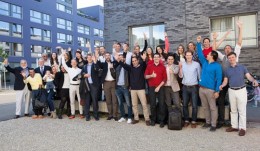

Learning from the Experts – Research Academy Lucerne
Research drives advances in science - this is why the Osteology Foundation is committed to running an intensive course on good scientific practice and research methodology. 26 participants from 12 different countries attended the Core Module in Lucerne this year. The one-week intensive course provided an overview of the planning and running of a study project from A to Z. In classroom sessions with leading experts, such as Niklaus Lang and Reinhard Gruber, case studies and exercises in teams the young researchers learned the Essentialsof Research Methodology, how to plan, conduct, evaluate and publish the results. The participants thereby particularly liked the highly interactive classes and the casual atmosphere. The interaction among the participants as well as the experts was regarded as extremely valuable. They discovered that they have very similar experiences and problems in their research practice despite coming from different countries and cultures from all-over the world, such as Egypt, Brazil, Europe and China. The dates for all up-coming courses can be found on the Osteology Research Academy website. Education Grants are available for participation in the courses. Application is possible online. Deadline: 1 December. I loved the informal atmosphere. The lecturers were engaging and inspiring, and gave me the opportunity to dispel several research doubts I had. Elena Calciolari, United Kingdom An outstanding, well-structured course, with the worlds best experts in the field of dental research. Mahmoud Shalash, Egypt I feel very privileged to have been selected for an education grant from the Osteology Foundation and to be attending the Osteology Research Academy, learning from great renowned professors. This will definitely make a big difference in my career. Vanessa Camillo de Almeida, Brazil (right in picture) The ORA Lucerne gave me the opportunity to meetinteresting colleaguesfrom all over the worldin a great atmosphere. Attending high-level presentations and workshops broadened my scientific horizon. Jonas Lorenz, Germany Attending the Research Academy Lucerne was of greatest value for gaining knowledge on practical aspects on clinical and pre-clinical research provided by experts from different disciplines. The great course environment provided the opportunity to interactively discuss and learn how to work within a team, especially during the workshops. Aliye Akcali, Turkey An excellent course for young clinicians that are heading for research in the field of oral tissue regeneration. Bo Chen, China -


Success beyond expectations: National Osteology Symposium Italy
Held in Florence from 1 to 3 October 2015, the Symposium strived to provide answers to the greatest clinical questions concerning modern regenerative dentistry, highlighting how essential it is to provide clarification regarding the data of scientific evidence and current knowledge for correct application of treatments in daily practice. Thursday, 1 October, started with the highly valuable contributions of Cristiano Tomasi and Maurizio Tonetti, who alternated in an intense discussion on the treatment of patients suffering from periodontitis: the focus was on case histories and communication with the patient to understand the importance of oral hygiene and periodic check ups. A very interesting event held in the afternoon, the Expert Forum on the Diagnosis and treatment of peri-implantitis, was attended by almost a thousand participants: Expert coordination by Mario Roccuzzo allowed balanced and punctual participation by the 7 speakers who examined and presented the various aspects of the state-of-the-art regarding peri-implant disease (Marco Aglietta, Tord Berghlund, Denis Cecchinato, Emilio Maschera, Mauro Merli, Stefan Renvert, Tiziano Testori). The main conclusions of the forum included confirmation by experts of the possibility of the treatment of peri-implantitis - albeit with certain limits, such as mal-positioning of the implant, the presence of minimum keratinised tissue and adequate periodontal conditions. Nonetheless there is still no commonly validated, accepted protocol. There was also high attendance at the theory-practical workshops of the Osteology Foundation which dealt with soft tissue management and aesthetic success in post-extraction sites (Daniele Cardaropoli/Paolo Casentini) and the management of periodontal and peri-implantar soft tissues (Raffaele Cavalcanti/Roberto Rotundo). The workshops of sponsor companies with Anton Sculean and Filippo Fontana were also sold out. After the inaugural message from the scientific Chairmen Pierpaolo Cortellini, Myron Nevins and Massimo Simion, on Friday, each session involved a debate between two speakers with great clinical experience. Giovanni Zucchelli and Francesco Cairo presented evidence and results regarding the coronally advanced flap technique, whether associated or not with grafting of connective tissue, in the treatment of single and multiple recessions. The use of the graft was found to be advantageous, but not always indispensable, suggesting the need to analyse the individual anatomical situations gums, papilla, crown, mandible/maxilla, extent of the defect - in the choice of the most appropriate treatment. Giulio Rasperini and Anton Sculean debated the treatment options for periodontal regeneration, during which closure of the flap by primary intention and selection of the correct combination of biomaterials on the basis of the severity of the defect were found to be essential factors. The role of the implant surface on the onset of peri-implantitis was the object of discussion for Tord Berghlund and Giovanni Polizzi. The strengths and weaknesses of the smooth and rough surfaces appeared to be evident; moreover, long-term results are necessary on the correlation between the onset of peri-implant disease and the type of surface. Mauro Merli and Carlo Tinti were the protagonists of the reports regarding the choice of GBR membranes. Although reinforced membranes have been a common therapeutic solution for extended bone augmentation for at least two decades, resorbable membranes can provide a successful, less invasive alternative, as long as a stable support is used which creates space and stabilises the graft and coagulum, conditions necessary for effective bone regeneration. On Saturday morning, starting with the Keynote lecture by Myron Nevins, the topic of large bone reconstructions was discussed. Excellent speeches by Matteo Chiapasco and Istvan Urban brought out the comparison of the best situations for using block grafts or GBR with biomaterials. In severe atrophies, the block of autologous bone remains the gold standard, but there are also several clinical situations wherein the correct use of mixtures of autologous bone and biomaterials, associated with resorbable membranes, make it possible to obtain an adequate, stable result. Urbans sausage technique is an example of the use of collagen membranes fixed with pins for horizontal augmentation, the volumetric stability of which is ensured by the presence of biomaterials that are resorbed slowly. Lastly, the moderators of the various sessions emphasised the Take home messages resulting from the reports and calling upon the participants to again vote on the treatment options of an illustrative case presented during the Symposium. Equally important was the Lunch for Learning dedicated to those under 35 which was sold out weeks before the start of the symposium: the group of young people worked with enthusiasm in diagnosis and in formulation of treatment plans under the guidance of expert tutors. The appointment with Forensic Medicine in Dentistry with Stefano Fiorentino was a huge success: it was the occasion for providing clarification regarding standards which regulate the use of medical devices, bone bank, blood derivatives and the possibilities of executing aesthetic medicine interventions. The winners of the contest for the best posters in the Basic research, Clinical research and Case report categories were Giulia Ghiacci (University of Parma), David Palombo (University of Milan) and Nicola Alberto Valente (University of Buffalo, NY), respectively. Three intensive days, each providing the participants with clinical advice to be applied immediately in practice, with the aim of optimising the diagnostic phase and the correct approach for each patient: from analysis of the defect to choice of the technique, from evaluation of the implant type to that of biomaterial, from preference for mini-invasiveness to correct information, all in the sole interest of the patients well-being. The scientific program can be viewed and downloaded from thewww.osteology-firenze.org See all photos from the event inThe Box. -

All about Hard Tissue Research - the Research Academy in Kiel
The 13 participants of the intensive course came from 10 countries from all-over the world to gain deeper insights into histology in oral bone regeneration. The Expert Module of the Osteology Research Academy comprises 13 hours of practical (in the laboratory) and 7 hours of theoretical advanced training on the following topics: Pre-clinical and clinical studies in bone regeneration MicroCT, histomorphometry and digital image analysis Bone anatomy, histology, physiology and bone pathophysiology Hard tissue sample preparation Data presentation: from the raw picture to the figure Asked about their experiences during the course the participants gave the following feedback: The professionalism and enthusiasm of all people involved, and the course have been an excellent steppingstone for someone like me who has been out of the research field since my postgraduate studies. Steven Soukoulis, Australia An inspiring course with great content that will be applicable for my future research. Monica Misawa, Brazil In very much enjoyed the workshops, tips and tricks for future projects and the 1:1 discussion with the experts. Dominic Ho, Hong Kong The next Expert Module will take place 7-9. November 2016 in Vienna. Further information For the third time the Osteology Foundation has organised the Osteology Research Academy Expert Module in Kiel. The course on Hard Tissue Research was held in collaboration with the Department of Maxillofacial Surgery at the University of Kiel. -
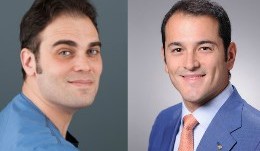

Expert Council extended
Gustavo Avila-Ortizis Associate Professor with Tenure at the Department of Periodontics at theUniversity of Iowa,USA, and alsoDirector of the Visiting Scholar Program at the same department. He holds a DDS and PhD degree from the University of Granada, Spain, and also a Master degree from the University of Michigan, USA. Gustavos profile in The Box Giorgio Pagniis Periodontistin private practice in Florence, Italy, and instructor at the University of Milan. Hereceived his DDS degree from the University of Firenze, Italy, and holds aMaster degree in Periodontics and Oral Medicine from the University of Michigan, USA. Giorgios profile in The Box The Osteology Expert Council was set up in 2010 in order to expand the Osteology Foundations international network and improve collaboration. Currently, it has 35 members that are a valuable part of the Foundation and drivers for innovative new projects within thethree committees. Both,Gustavo Avila-Ortiz, as well as Giorgio Pagni have already tremendously contributed to past and ongoing projects of the Foundation, in particular to the development of THE BOX. Gustavo Avila-Ortiz (left), and Giorgio Pagni More information about the Osteology Expert Council The Osteology Foundation Board has elected two new members to its Expert Council: Gustavo Avila-Ortiz, USA, and Giorgio Pagni, Italy. Both have already contributed to the Foundations activites over the last years. -

DGI meets Osteology Foundation
At the 30th annual congress of the DGI, the German Society for Implantology (Deutsche Gesellschaft für Implantologie), which will take place on 24 26 November in Hamburg, Germany, the Osteology Foundation will contribute to the program with a session jointly organised with the DGI. The title of the session on Saturday, 26 November, is Science meets everyday practice and comprises presentations as well as interactive discussion. It is chaired by the DGI Committee Nexte Generation and the Osteology Expert Council. Moderators are Frank Schwarz (President DGI, OF Board), Ilja Mihatovic (OF Expert Council, DGI Nexte Generation), and Christian Schmitt (OF Expert Council). The session will be held in German. Registration and further information on the DGI congress website. Programme 11:20 - 11:30 Eröffnung der DGI/Osteology Session Introduction of Osteology Foundation F. Schwarz, Düsseldorf 11:30 - 11:55 Wissenschaft für die tägliche Praxis: Knochenmetabolismus R. Gruber, Wien, A 11:55 - 12:20 Wissenschaft für die tägliche Praxis: Chirurgische Faktoren fr den Langzeiterfolg von Implantaten D. Buser, Bern, CH 12:20 - 12:45 Wissenschaft für die tägliche Praxis: Augmentative Verfahren B. Al-Nawas, Mainz, D 12:45 - 13:10 Interaktive Podiumsdiskussion: Was hat sich klinisch bewhrt und welche Fragen muss die Wissenschaft noch beantworten? -
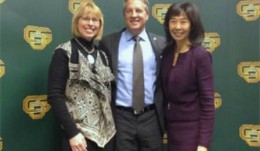

AAP Collaboration: Workshop Proceedings published
Enhancing Periodontal Health Through Regenerative Procedures Fifty-two workshop participants met in Chicago last summer to conduct a systematic review of existing literature, culminating in the development of consensus reports and practical applications to aid practitioners in the clinical environment. Topics of the workshop included the following: Periodontal Soft Tissue Root Coverage Procedures: Managing gingival recession based on current evidence with a primary outcome goal of complete root coverage Periodontal Soft Tissue Non-Root Coverage Procedures: Assessing the need for gingival augmentation procedures (non-root coverage) around natural teeth Intrabony Defects: Periodontal regenerative strategies for the management of intrabony periodontal defects Furcation Defects: How periodontal furcation defects should be managed via periodontal regenerative therapy and what parameters should be used for treatment selection Emerging Regenerative Approaches for Periodontal Reconstruction: Can emerging technologies for periodontal regeneration become clinical reality? Each practical applications paper describes a specific clinical situation, different approaches that may be considered in its management, and how an expert makes a treatment decision based on the provided evidence. Clinical Advances in Periodontics also offers illustrative images and videos that further detail the clinical situation, how it was managed, and its expected treatment outcomes. How the workshop came to be and what the findings mean for periodontal practice The2014 AAP Regeneration Workshopon the topic Enhancing Periodontal Health Through Regenerative Procedures was of huge interest to the Osteology Foundation, and therefore it was supported with an educational grant. The international consensus meetingwas co-chaired by theOsteology BoardmembersWilliam V. GiannobileandPamela K. McClain. We are excited to announce that the proceedings of this workshop have now been published in a special supplement of the Journal of Periodontology, and are available online with free access. Proceedings of the 2014 AAP Regeneration Workshop The publication is a great result of the first joined efforts of the AAP and the Osteology Foundation. The results havedemonstrated that regenerative procedures are effective and predictable treatment options for helping patients retain their natural dentition. The workshop was an amazing collaborative effort that provides the most current consensus of therapies and technologies in regenerative treatment, sayd AAP president Joan Otomo-Corgel at a press-conference in Chicago, when the publication was announced. Were thrilled to share the results of the these dynamic discussions. This bell weather information will provide tremendous benefit to the periodontal specialty, the dental community, and the patients we treat. -
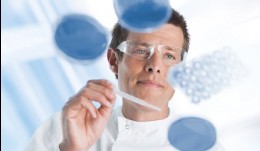

Osteology Researcher Grants - apply now!
The Osteology Foundation offers besides its established Advanced Researcher Grants a special grant program for young researchers: the Osteology Young Researcher Grants, which support researchers in realizing their own research project and fuelling their research career. The Osteology Young Researcher Grants program (new since 2014) is addressed to all clinicians and researchers (primary investigators) currently undergoing post-graduate education or within three years thereafter. The grants are limited to 30000 Swiss Francs with a maximum project duration of one year. The new Young Researcher Program is dedicated to projects with sound hypothesis, and aims that show thinking out of the box. The Osteology Advanced Researcher Grants program is addressed to clinicians and researchers at universities and in private practice (having an university affiliation) conducting research in the field of dental tissue regeneration. It is dedicated to projects with hypothesis and aims focusing on clinical relevance bolstered with preliminary work within a research group setting. In general, grants are limited to 100000 Swiss francs with a maximum project duration of two years. If you have an interesting research project fitting to one of the Osteology Foundation grants programmes you are invited to submit your application before June 15, 2015. Detailed information as well as the application guidelines for the research and education grants are available from the Osteology Website. -
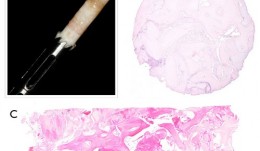

Study Protocols: Maxillary Sinus Floor Elevation
based on the book chapter by Gustavo Avila-Ortiz andPablo Galindo-Moreno Summary This technique is used to gain bone height in posterior atrophic maxillary segments before implant placement. It is increasingly used in patients with maxillary sinuses that are too close to the upper jaw or excessive bone reabsorption from gum disease. Endpoints relate to the amount of new bone formation after grafting and survival of implants and implant-supported prostheses. and long-term success rates are high. It is also excellent for studying healing following grafting with different materials and regenerative strategies in large craniofacial defects. The protocol described here is based on a hypothetical study, and covers patient screening, selection, enrolment and randomization, including a sample size calculation (which is omitted in most published studies). There are multiple phases for planning and executing the sinus elevation, followed by post-operative evaluation, and further planning and placement of implants. Detail is given on the length and form of patient visits for evaluations using cone-beam CT, impressions, photos, clinical measures, bone biopsies and adverse events recording. The discussion is supplemented by images of bone core histology and diagrams of the paranasal sinuses, and the authors point out the difference between crestal and lateral approaches. The lateral approach is illustrated throughout, including follow-up at 24 weeks and implant placement. The authors also address the problems of membrane perforation and nasal meatus occlusion. Open full-text PDF (1.9 MB)











